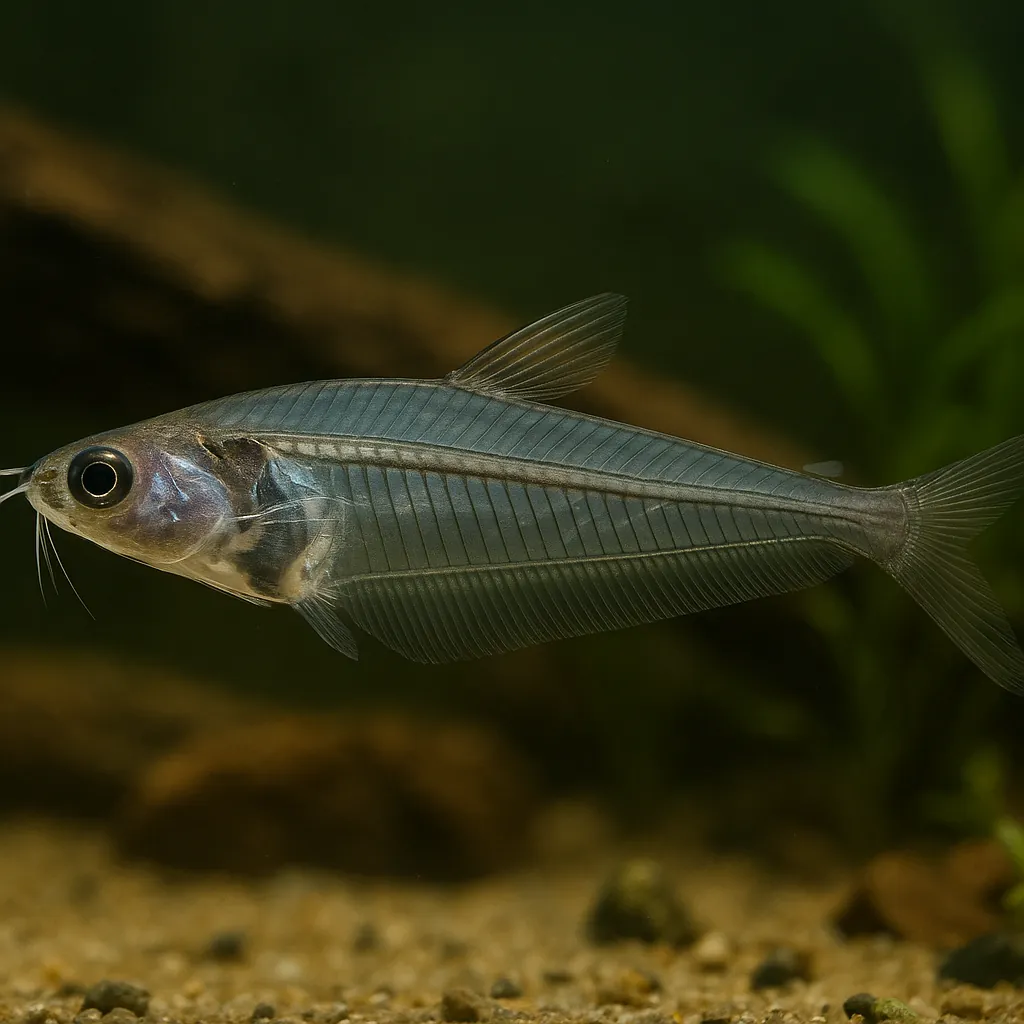
Glass catfish
Introduction
The Glass Catfish, known scientifically as Kryptopterus vitreolus, is a captivating freshwater species cherished by aquarists for its unique, transparent body that reveals its internal structure. This distinctive appearance, combined with its peaceful nature, makes it a popular choice for community aquariums. While they are relatively hardy, Glass Catfish require specific care to thrive, making them suitable for aquarists with some experience.
Care and Environment
Providing optimal care for Glass Catfish involves attention to tank size, water parameters, filtration, lighting, diet, and tank setup.
What is the minimum tank size for Glass Catfish?
A minimum tank size of 75 liters is recommended to accommodate a small group of Glass Catfish, as they are schooling fish that thrive in groups of at least five to six individuals.
What are the ideal water parameters for Glass Catfish?
Maintaining stable water conditions is crucial. Ideal parameters include a temperature range of 24°C to 27°C, a pH between 6.5 and 7.5, and water hardness from 2 to 12 dGH. Regular monitoring and maintenance are essential to prevent stress and health issues.
How should the tank be set up for Glass Catfish?
Glass Catfish prefer a well-planted aquarium with ample hiding spots. Incorporate live plants like Java Fern and Anubias, along with driftwood and rocks, to mimic their natural habitat. A gentle filtration system is recommended to maintain clean water without creating strong currents, as these fish favor slow-moving waters. Subdued lighting, possibly enhanced with floating plants, can help them feel secure and encourage natural behavior.
In terms of diet, Glass Catfish are omnivorous. In captivity, they can be fed a variety of small, protein-rich foods such as live or frozen bloodworms, daphnia, brine shrimp, micro-pellets, and high-quality flakes. Due to their small mouths, feed them small-sized foods that they can easily consume. Feeding 2-3 times a day in small portions will help them maintain good health.
Origin and Habitat
Glass Catfish are native to the freshwater rivers and streams of Southeast Asia, particularly in Thailand. They inhabit slow-moving, clear waters with dense vegetation and soft substrates. These environments provide ample hiding spots and a steady supply of small invertebrates, which constitute their natural diet. Seasonal variations, such as monsoon rains, can influence water conditions, but Glass Catfish are adapted to relatively stable environments.
Temperament and Compatibility
Glass Catfish are peaceful, schooling fish that exhibit their best behavior when kept in groups of at least five to six individuals. In smaller groups, they may become shy and reclusive. Their non-aggressive nature makes them excellent candidates for community tanks.
What are suitable tank mates for Glass Catfish?
Compatible tank mates include other peaceful species such as tetras (e.g., Neon Tetras, Rummy Nose Tetras), rasboras, corydoras catfish, and small gouramis. These species share similar temperaments and environmental requirements.
Are there any fish that should be avoided as tank mates?
Avoid housing Glass Catfish with aggressive or overly boisterous fish like large cichlids or fin-nippers such as tiger barbs, as they may stress or harm the Glass Catfish.
How can I create a harmonious tank environment for Glass Catfish?
To foster a harmonious environment, ensure the tank is spacious enough to accommodate all inhabitants comfortably, provide plenty of hiding spots, and maintain stable water conditions. Keeping Glass Catfish in appropriate group sizes and with compatible species will promote natural behavior and reduce stress.
Interesting Facts
Glass Catfish possess several intriguing characteristics that enhance their appeal to aquarists.
Why are Glass Catfish transparent?
Their transparency is due to the lack of body pigmentation, allowing a clear view of their internal organs and skeletal structure. This adaptation may serve as camouflage in their natural environment.
How long do Glass Catfish typically live?
With proper care, Glass Catfish can live between six to eight years in captivity, making them a long-term commitment for aquarists.
Is breeding Glass Catfish in captivity common?
Breeding Glass Catfish in home aquariums is extremely rare and challenging. Their specific breeding habits are not well-documented, and successful reproduction often requires replicating precise environmental conditions that are difficult to achieve in captivity.
Sources
All information in this article has been gathered from the following reputable sources:
Overview
Recommended Tank Size 29.9 Gallons (. for groups of 5 or more) |
Minimum Group Size 5 |
Minimum Tank Volume 19.8 Gallons |
Maximum Adult Length 3.1 inches |
Average Adult Length 2.4 inches |
Shoaling (6+ required) Yes |
Preferred Water Type Freshwater, soft, slightly acidic |
Temperature Range (°C) 24–27 |
pH Range 6.5–7.5 |
Water Hardness (dGH) 2–12 |
Typical Lifespan (years) 6 years |